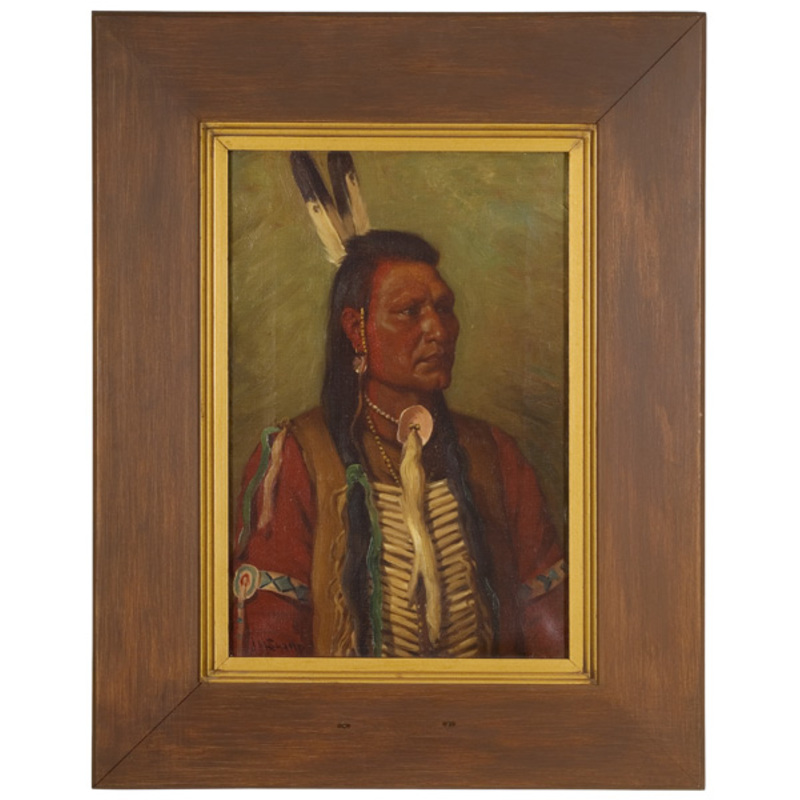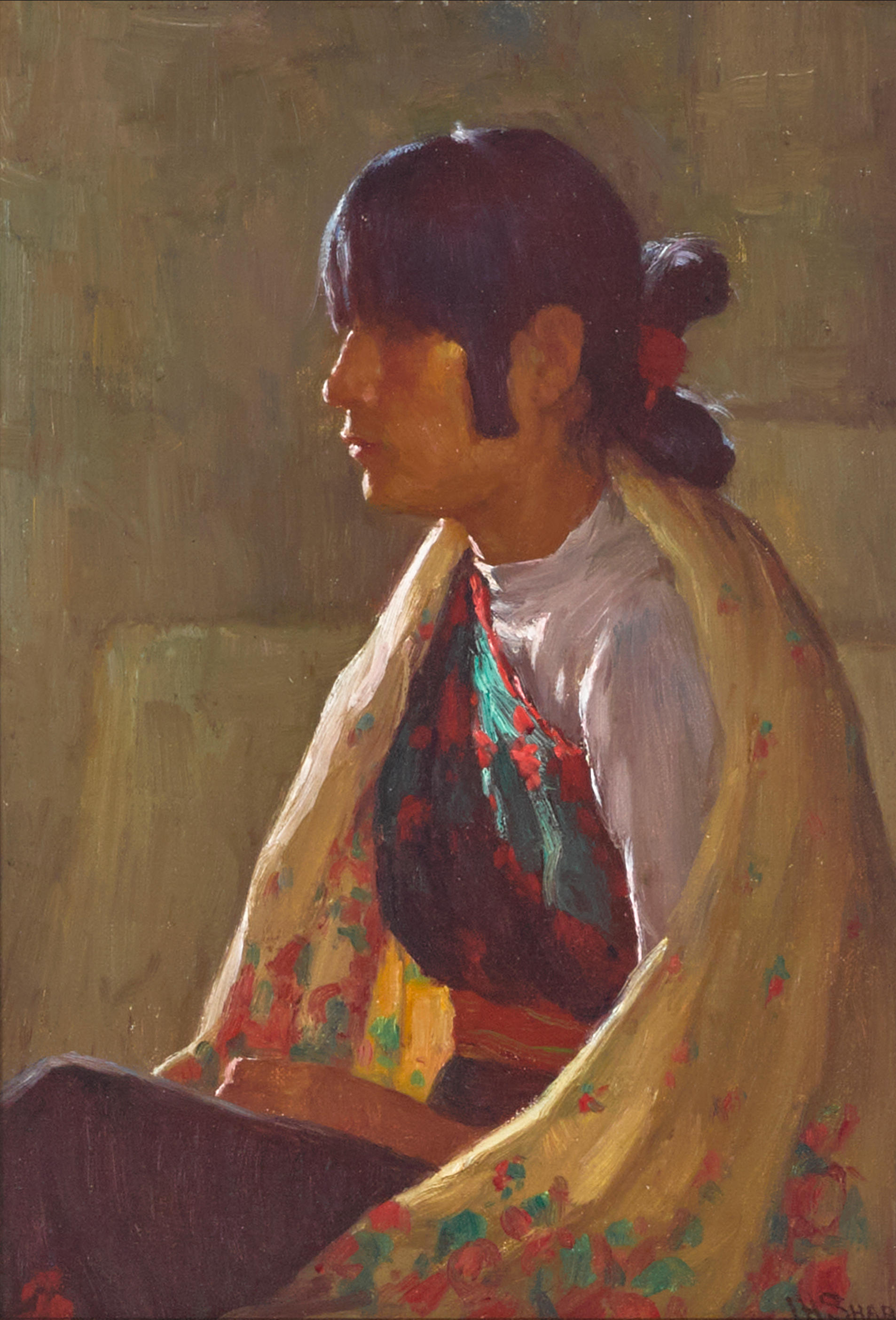oil on canvas, signed lower right, and titled and signed on verso. Retains original Taos Society price tag and is in its original frame; 25" x 30" (w/o frame), 36" x 41" (w/frame). Joseph Henry Sharp (1859-1953) is considered the father of the Taos Society of Artists. His extraordinary output of paintings in his long career made him one of the most prolific and prominent painters of the American Indian. Although he is known for his images of the American west, his other accomplishments included years of teaching in Cincinnati and publication of his works in several magazines. Sharp was born in Bridgeport, Ohio in 1859. When he was a boy, his hearing was severely damaged as a result of a near-drowning incident. At age 12, his father died, and at age 14, Sharp was forced to drop out of school because his hearing loss had deteriorated and was virtually complete. Sharp then moved to Cincinnati to live with his aunt, and it was here that his formal art education began. He managed to enroll in the McMicken School of Design while still working and providing his mother with financial support. Afterwards he continued at the Cincinnati Art Academy and at age 22, he took his first trip abroad to Antwerp. Over the next decade, Sharp would study in Munich, Spain, Italy and Paris with notable artists such as Karl Marr and Cincinnati friend Frank Duveneck In Cincinnati, Sharp was a student of Henry Farny, another renowned painter of Indians. Sharp insisted on going West and it was suggested by Farny that he study the Pueblo Indians of New Mexico. His first trip was to Santa Fe in 1882. In 1893, Sharp discovered the Taos area, and became fascinated by the mixture of Indian and Spanish cultures. He also began teaching figure painting the year before at the Cincinnati Art Academy, and during the next several years he often split his time between Taos and Cincinnati, where he taught figure painting at the Art Academy. Sharp, however, did not restrict himself to Taos and its inhabitants. He realized that the Plains Indians were moving towards extinction, so he made several trips north, especially to document Indian survivors of the Battle of Little Big Horn. Having achieved significant success with his artistic pursuits, Sharp resigned his teaching position in Cincinnati in 1902 and split his time between the Crow Agency in Montana and Taos. He was rapidly becoming the most highly regarded portrait artist of American Indians. In Montana alone, Sharp executed over 200 portraits of Plains Indians. After he had exhausted his possibilities at the Crow Agency, he moved permanently to Taos in 1912. From there he continued to work and travel until his death in 1953 at age 93. While Sharp is revered in the artistic community for the founding of the Taos Society, one can persuasively argue that his contribution to study of the history and culture of the American Indian is far more important. He left behind thousands of paintings, and his documentation of Indian life is unrivaled. It was his constant goal to capture the essence of Indian life during a period when their cultures were slowly deteriorating. Indian Medicine or Black Robe? is one of Sharp’s more profound, complicated, and provocative works. The subject is an Indian, in this case Elk Foot, seated in a bare interior contemplating his spiritual beliefs. He leans against the wall, staring down at a bundle of eagle feathers—his Indian medicine, while he grapples with the prospect of Christianity, illustrated by the crucifix on the wall. On the back of this painting is an original label, in Sharp’s hand: INDIAN MEDICINE OR BLACK ROBE. The Indian designates the Christian religion by the word "blackrobe" - In his hands is his "spiritual medicine", various charms to keep evil spirits away and propitiate the gods - It is a study of the conflicting emotions between his own religion and Christianity. J.H. Sharp. Such thematic constructions were not uncommon in Sharp’s work, given his art historical backgr
oil on canvas, signed lower right, and titled and signed on verso. Retains original Taos Society price tag and is in its original frame; 25" x 30" (w/o frame), 36" x 41" (w/frame). Joseph Henry Sharp (1859-1953) is considered the father of the Taos Society of Artists. His extraordinary output of paintings in his long career made him one of the most prolific and prominent painters of the American Indian. Although he is known for his images of the American west, his other accomplishments included years of teaching in Cincinnati and publication of his works in several magazines. Sharp was born in Bridgeport, Ohio in 1859. When he was a boy, his hearing was severely damaged as a result of a near-drowning incident. At age 12, his father died, and at age 14, Sharp was forced to drop out of school because his hearing loss had deteriorated and was virtually complete. Sharp then moved to Cincinnati to live with his aunt, and it was here that his formal art education began. He managed to enroll in the McMicken School of Design while still working and providing his mother with financial support. Afterwards he continued at the Cincinnati Art Academy and at age 22, he took his first trip abroad to Antwerp. Over the next decade, Sharp would study in Munich, Spain, Italy and Paris with notable artists such as Karl Marr and Cincinnati friend Frank Duveneck In Cincinnati, Sharp was a student of Henry Farny, another renowned painter of Indians. Sharp insisted on going West and it was suggested by Farny that he study the Pueblo Indians of New Mexico. His first trip was to Santa Fe in 1882. In 1893, Sharp discovered the Taos area, and became fascinated by the mixture of Indian and Spanish cultures. He also began teaching figure painting the year before at the Cincinnati Art Academy, and during the next several years he often split his time between Taos and Cincinnati, where he taught figure painting at the Art Academy. Sharp, however, did not restrict himself to Taos and its inhabitants. He realized that the Plains Indians were moving towards extinction, so he made several trips north, especially to document Indian survivors of the Battle of Little Big Horn. Having achieved significant success with his artistic pursuits, Sharp resigned his teaching position in Cincinnati in 1902 and split his time between the Crow Agency in Montana and Taos. He was rapidly becoming the most highly regarded portrait artist of American Indians. In Montana alone, Sharp executed over 200 portraits of Plains Indians. After he had exhausted his possibilities at the Crow Agency, he moved permanently to Taos in 1912. From there he continued to work and travel until his death in 1953 at age 93. While Sharp is revered in the artistic community for the founding of the Taos Society, one can persuasively argue that his contribution to study of the history and culture of the American Indian is far more important. He left behind thousands of paintings, and his documentation of Indian life is unrivaled. It was his constant goal to capture the essence of Indian life during a period when their cultures were slowly deteriorating. Indian Medicine or Black Robe? is one of Sharp’s more profound, complicated, and provocative works. The subject is an Indian, in this case Elk Foot, seated in a bare interior contemplating his spiritual beliefs. He leans against the wall, staring down at a bundle of eagle feathers—his Indian medicine, while he grapples with the prospect of Christianity, illustrated by the crucifix on the wall. On the back of this painting is an original label, in Sharp’s hand: INDIAN MEDICINE OR BLACK ROBE. The Indian designates the Christian religion by the word "blackrobe" - In his hands is his "spiritual medicine", various charms to keep evil spirits away and propitiate the gods - It is a study of the conflicting emotions between his own religion and Christianity. J.H. Sharp. Such thematic constructions were not uncommon in Sharp’s work, given his art historical backgr














Testen Sie LotSearch und seine Premium-Features 7 Tage - ohne Kosten!
Lassen Sie sich automatisch über neue Objekte in kommenden Auktionen benachrichtigen.
Suchauftrag anlegen